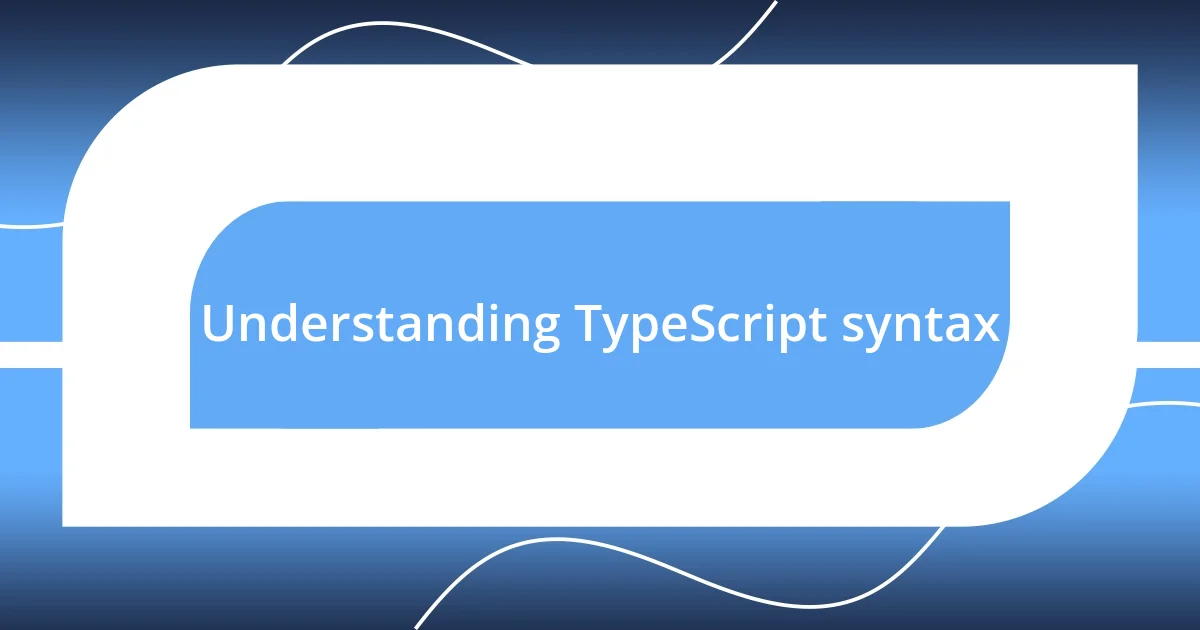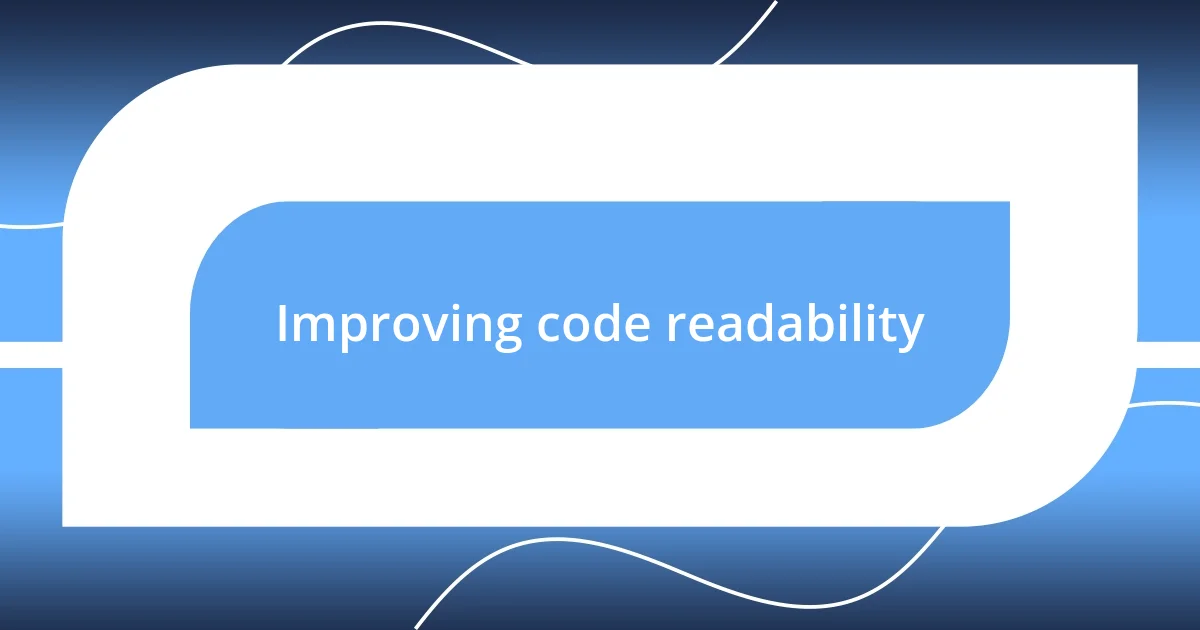Key takeaways:
- TypeScript’s strict typing and type annotations significantly enhance code clarity and maintainability, reducing ambiguity and improving collaboration among team members.
- The use of features like interfaces, enums, and generics empowers developers to create organized, versatile, and reusable code, contributing to better structure and readability.
- Early error detection through static typing and proactive coding practices boosts confidence and overall code quality, making debugging more efficient and reducing runtime issues.

Understanding TypeScript syntax
When I first started with TypeScript, I was pleasantly surprised by how its syntax feels both familiar and rich. It merges the best of JavaScript with static typing, which means you get to define the types of variables upfront. I remember the first time I declared a variable with a specific type; it was like a light bulb went off. I realized that this little addition improved my code’s readability and maintainability significantly. Have you ever found yourself scratching your head over a variable’s type? TypeScript helps eliminate those moments of confusion.
The syntax might seem a bit daunting at first, especially with features like interfaces and generics, but I found that tackling them one by one turned learning into an exciting journey. For instance, creating an interface to define the structure of an object gave me a newfound confidence in my ability to predict how my objects would interact. It felt like building a sturdy foundation for a house; without it, everything would feel shaky and unreliable.
I also noticed TypeScript allowed me to catch errors earlier in the development process. When I was creating a complex function, the compiler flagged potential issues before I even ran the code. This proactive approach not only saved me from hours of debugging but also made me feel more competent in my coding abilities. Isn’t it reassuring to know that TypeScript watches your back while you code?

Key differences from JavaScript
When transitioning to TypeScript, one of the first noticeable differences from JavaScript is the introduction of strict typing. I’ll never forget the moment when I realized that I could specify whether a variable was a string, number, or even a more complex type. It felt empowering, like suddenly wearing glasses and being able to see the whole picture clearly. This change not only resulted in fewer unexpected surprises during runtime but also made collaborating with teammates smoother, as everyone could immediately grasp the intended data structures.
Here are some key differences that stood out to me:
- Type Annotations: You define variable types explicitly, enhancing clarity.
- Interfaces: I started using interfaces to outline object shapes, making my code much cleaner.
- Enums: Using enums added an expressive layer to my code that enums in JavaScript simply lack.
- Optional Chaining: This feature allowed me to safely access deeply nested properties without worrying about runtime errors.
- Generics: They helped me create reusable components, and it felt like I discovered a magical toolbox for dynamic programming.
Each of these differences not only shifted my coding style but also deepened my understanding of how to structure my code more thoughtfully.

Benefits of static typing
Static typing has transformed my approach to coding in ways I never anticipated. The clarity it brings to my code is one of its greatest benefits. I remember debugging a multi-layered application where variable types were ambiguous. It felt like searching for a needle in a haystack. With TypeScript, I can declare types explicitly, leading to code that reads like a well-crafted narrative. This clarity fosters better collaboration among team members since we’re all on the same page regarding the data structures in use.
Another advantage of static typing is the reduction of runtime errors. Early on in my project work, I fell victim to not catching a simple type mismatch that caused significant headaches. TypeScript’s compiler acts like a friendly guardian, identifying these mistakes at compile time. I feel more secure knowing that I have a vigilant ally preventing errors from slipping by unnoticed. That moment of validation when the compiler flags an issue before I run the code is not just reassuring; it builds my confidence.
Lastly, one of the most delightful aspects is how static typing enhances my code’s maintainability over time. I recall a situation where I had to revisit an old project, and the lack of type annotations made it cumbersome to figure out what each function was supposed to accomplish. With TypeScript, my legacy code is much easier to navigate; it feels like having a GPS for my code base! I can change a variable’s type with the comfort that TypeScript will alert me to necessary adjustments elsewhere. This empowerment is something I deeply cherish in my development journey.
| Benefits | Explanation |
|---|---|
| Clarity in Code | Declaring types explicitly removes ambiguity, leading to easier code comprehension for all team members. |
| Early Error Detection | Static typing allows the compiler to catch errors before runtime, reducing the chances of bugs and increasing confidence. |
| Enhanced Maintainability | Type annotations make legacy code more navigable, simplifying updates and adjustments over time. |

Improving code readability
One of the most transformative aspects of TypeScript for me has been the significant improvement in code readability. I still recall the moment I was knee-deep in a project filled with loosely typed JavaScript; it felt like reading a book where the chapters were out of order. Once I embraced TypeScript’s type annotations, everything changed. Every variable became a clear statement of purpose. I remember the satisfaction of writing a function and, instead of grappling with what types I needed to pass, I could simply look at the definitions and instantly understand how to use them. Isn’t it liberating to have that kind of clarity?
I’ve also found that interfaces have been game-changers in my quest for readable code. When I first started incorporating them, it was like discovering a secret language that made my intent explicit. Instead of just passing around objects filled with various properties, I could define a blueprint of what those objects should look like. I can still picture a team meeting where we discussed a data model, and just sketching out an interface helped us align our thoughts seamlessly. Have you ever experienced that moment when everything clicks into place? It’s incredibly fulfilling!
Additionally, the optional chaining feature feels like a breath of fresh air, especially in complex applications with nested properties. I used to dread accessing deeply nested data, always on edge about whether I’d hit a roadblock. With TypeScript, I found myself confidently navigating through those structures, knowing that I wouldn’t be met with runtime exceptions. The sense of relief that washed over me when I accessed properties without a hitch is hard to put into words. It’s moments like these that remind me of why I love coding; there’s something special about feeling in control and making sense of a codebase that could have easily spiraled into chaos.

Enhancing error detection
When I first ventured into TypeScript, I was astonished by how drastically it improved my ability to identify errors early on. In my earlier JavaScript projects, I often felt like a detective working in a dimly lit room, searching for clues that didn’t even seem to exist. I recall a particularly trying night where a seemingly innocuous variable name was the root cause of a critical bug. With TypeScript, the type system shines a light on potential issues before they become costly problems, guiding me away from that frustrating experience.
Static typing has truly transformed my relationship with error handling. I remember tackling a complex function where the parameters had varying types, leading to cascade failures that sent me down rabbit holes of confusion. Now, the thrill of watching TypeScript catch those errors at compile time feels like receiving a gentle nudge in the right direction rather than a punch in the gut later in the development process. It’s almost like having a mentor by my side, ensuring I’m on the right track before I set my code into the wild.
One of the things I’ve grown to love about TypeScript’s error detection is how it encourages a proactive mindset. I’ve found that the more I embrace its features, the more vigilant I become about my code’s integrity. For instance, when I see a type warning, I no longer feel a sense of dread; instead, it feels empowering as I can resolve issues before they manifest in a live environment. Have you ever felt that rush of relief when you catch a mistake just in time? It’s events like these that reaffirm my belief in the power of TypeScript, enhancing both my confidence and the quality of my work.

Adopting TypeScript features
In adopting TypeScript features, I discovered a newfound appreciation for generics. Initially, they seemed daunting, but the more I used them, the clearer their benefits became. I remember the first time I implemented a generic function—it was a revelation! It felt like I was suddenly given a tool that allowed me to create versatile solutions without sacrificing type safety. Have you ever experienced that thrill when a concept finally clicks? The versatility generics offer has genuinely expanded my coding horizon.
Exploring TypeScript’s enums has also transformed the way I handle constants in my projects. In my earlier JavaScript adventures, I often relied on string and number literals, only to find myself tangled in a web of magic values. Once I embraced enums, it was like flipping on a light switch. I vividly recall refactoring a large codebase where the introduction of enums not only clarified my intent but also improved maintainability. It’s amazing how something so simple can lead to such profound clarity—don’t you just love that sense of order?
TypeScript’s ability to integrate with existing JavaScript code is another feature I’ve appreciated immensely. When I first started transitioning parts of my JavaScript projects to TypeScript, I was nervous about potential compatibility issues. However, as I took baby steps, incorporating TypeScript gradually felt like fitting puzzle pieces together. I can still recall the satisfaction of watching my old code gain structure and purpose, shifting from loosely typed chaos to a more formalized, organized framework. It’s such a rewarding process—doesn’t it make you feel excited about the possibilities?

Real-world coding style examples
One particular instance that stands out in my coding journey was when I decided to implement TypeScript’s strict mode in a project. This choice undoubtedly elevated my coding style. I remember pouring over the settings, and with each checkbox I ticked, I felt a mix of excitement and trepidation. The early days were a bit challenging—there were more errors than I anticipated—but it pushed me to think critically about each function I wrote. How often do we default to writing code without fully considering its implications? That experience taught me to be intentional and thorough, ultimately resulting in more robust applications.
Another significant change came when I began adopting the readonly modifier in my type definitions. I find it particularly empowering, as it guards against accidental mutations of vital objects. I recall working on a project where a small change in state cascaded into significant bugs, much to my dismay. Now, by using readonly, I can create a comfort zone where my variables remain unchanged, allowing me to focus on the logic at hand. It’s like setting a guardrail on a winding road—don’t you find it reassuring to know certain variables are safely off-limits?
Lastly, I firmly believe that how I structure my interfaces has drastically improved thanks to TypeScript. In the past, I would throw together hastily defined objects, sometimes leading to confusion later on. However, I recall a project where I took the time to define clear interfaces. This decision transformed how my teammates interacted with my code and helped me notice patterns more easily. It’s like a well-organized toolbox; when everything is labeled and categorized, it’s far more enjoyable to dive in and get to work, isn’t it? I genuinely feel that embracing these TypeScript features has enriched my coding style, infusing both confidence and clarity into my workflow.














